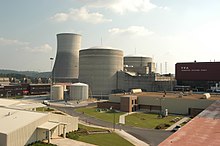Sequoyah Nuclear Generating Station
| Sequoyah Nuclear Plant | |
|---|---|
 |
|
| Country | United States |
| Location | Hamilton County, near Soddy-Daisy, Tennessee |
| Coordinates | 35°13′35″N 85°5′30″W / 35.22639°N 85.09167°WCoordinates: 35°13′35″N 85°5′30″W / 35.22639°N 85.09167°W |
| Status | Operational |
| Construction began | 1969–80 |
| Commission date | Unit 1: July 1, 1981 Unit 2: June 1, 1982 |
| Operator(s) | Tennessee Valley Authority |
| Nuclear power station | |
| Reactor type | pressurized water reactor |
| Reactor supplier | Westinghouse |
| Cooling source | Chickamauga Lake |
| Cooling towers | 2 |
| Power generation | |
| Units operational | 1221 MW 1200 MW |
| Capacity factor | 89.1% |
| Annual output | 17,754 GWh |
|
Website www.tva.gov/power/nuclear/sequoyah.htm |
|
The Sequoyah Nuclear Plant is a nuclear power plant located on 525 acres (212 ha) located 7 miles (11 km) east of Soddy-Daisy, Tennessee, and 20 miles (32 km) north of Chattanooga, abutting Chickamauga Lake, on the Tennessee River. The facility is owned and operated by the Tennessee Valley Authority (TVA).
The plant has two Westinghouse pressurized water reactors. Sequoyah units 1 & 2, as well as their sister plant at Watts Bar, both have ice condenser containment systems. In case of a large loss-of-coolant accident, steam generated by the leak is directed toward borated ice which helps condense the steam creating a lower pressure, allowing for a smaller containment building.
Sequoyah's two units have a winter net dependable capacity of 2,333 megawatts, making Sequoyah the most productive of TVA's four nuclear plants. Sequoyah is the second-most powerful electric plant in the entire TVA system, second only to the Cumberland coal-fired plant northwest of Nashville. Following the restart of Brown's Ferry Unit 1, that plant again became most productive at 3,440 MW.
The operating license of Sequoyah's Unit 1 was originally set to expire in 2020, and Unit 2's operating license in 2021. In 2015, the NRC renewed the operating license for both units for an additional 20 years.
TVA constructed dry cask storage facilities at Sequoyah and purchased special storage containers for the purpose of storing spent nuclear fuel. The storage facilities have been approved by the NRC.
TVA's Sequoyah operating license was modified in September 2002 to allow TVA to irradiate tritium-producing burnable absorber rods at Sequoyah for the U.S. Department of Energy. The process of irradiating tritium-producing rods produces tritium, which is used in nuclear weapons and for various forms of research into nuclear fusion for commercial power production. TVA began irradiating tritium-producing rods at its Watts Bar Nuclear Generating Station in 2003. As of February 2007, TVA had no plans to produce tritium at Sequoyah.
...
Wikipedia

